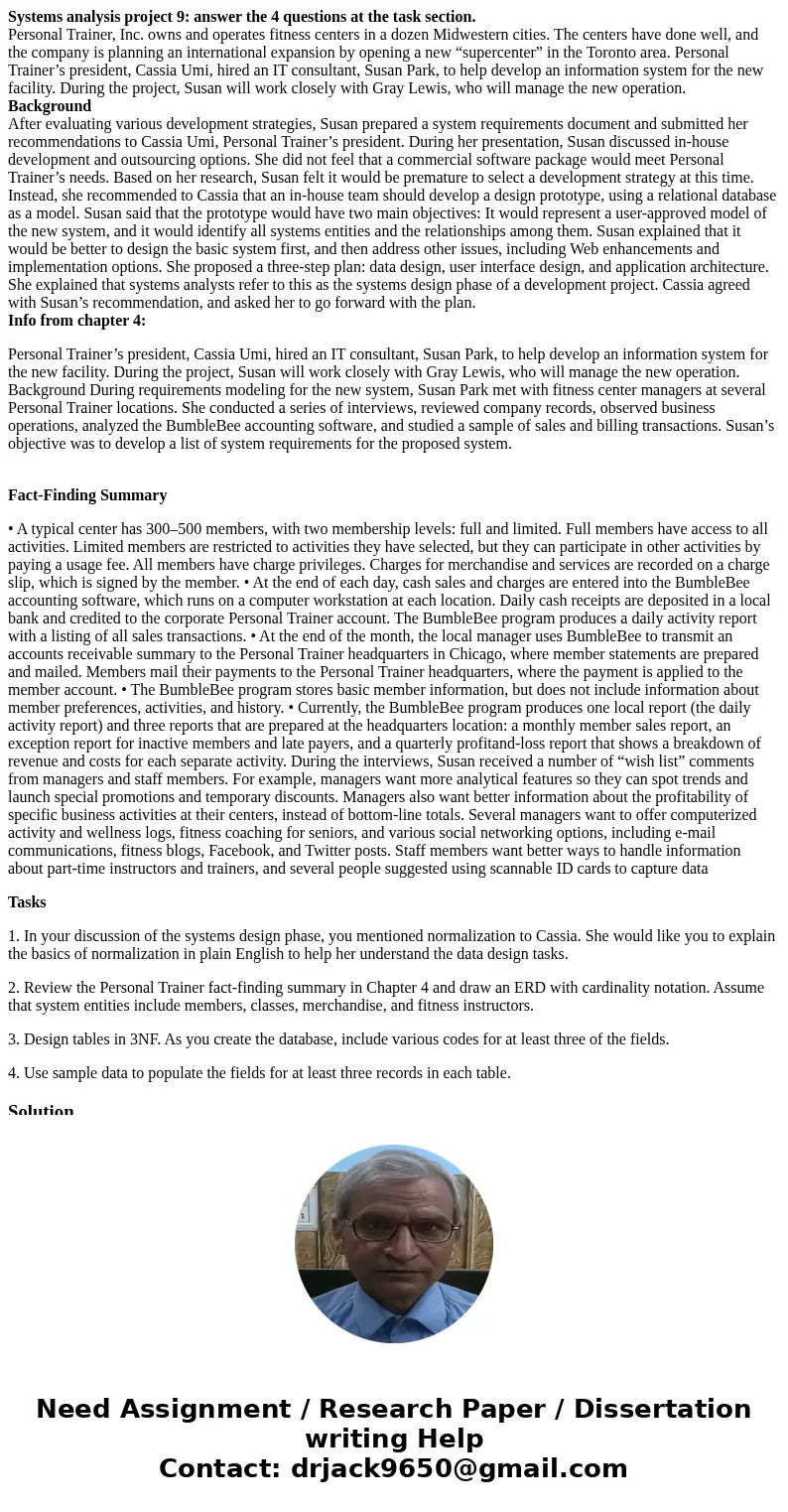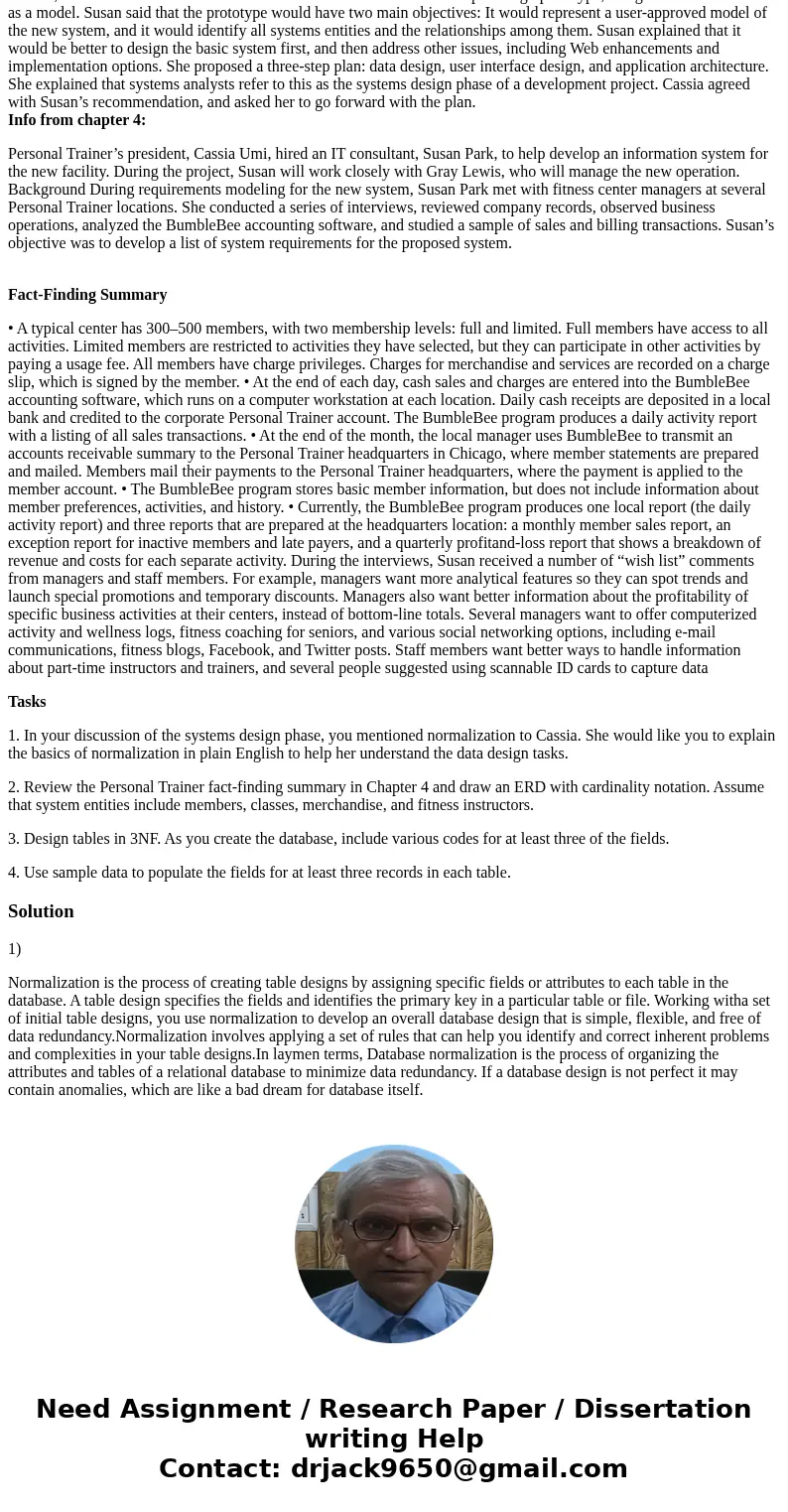Systems analysis project 9 answer the 4 questions at the tas
Systems analysis project 9: answer the 4 questions at the task section.
Personal Trainer, Inc. owns and operates fitness centers in a dozen Midwestern cities. The centers have done well, and the company is planning an international expansion by opening a new “supercenter” in the Toronto area. Personal Trainer’s president, Cassia Umi, hired an IT consultant, Susan Park, to help develop an information system for the new facility. During the project, Susan will work closely with Gray Lewis, who will manage the new operation.
Background
After evaluating various development strategies, Susan prepared a system requirements document and submitted her recommendations to Cassia Umi, Personal Trainer’s president. During her presentation, Susan discussed in-house development and outsourcing options. She did not feel that a commercial software package would meet Personal Trainer’s needs. Based on her research, Susan felt it would be premature to select a development strategy at this time. Instead, she recommended to Cassia that an in-house team should develop a design prototype, using a relational database as a model. Susan said that the prototype would have two main objectives: It would represent a user-approved model of the new system, and it would identify all systems entities and the relationships among them. Susan explained that it would be better to design the basic system first, and then address other issues, including Web enhancements and implementation options. She proposed a three-step plan: data design, user interface design, and application architecture. She explained that systems analysts refer to this as the systems design phase of a development project. Cassia agreed with Susan’s recommendation, and asked her to go forward with the plan.
Info from chapter 4:
Personal Trainer’s president, Cassia Umi, hired an IT consultant, Susan Park, to help develop an information system for the new facility. During the project, Susan will work closely with Gray Lewis, who will manage the new operation. Background During requirements modeling for the new system, Susan Park met with fitness center managers at several Personal Trainer locations. She conducted a series of interviews, reviewed company records, observed business operations, analyzed the BumbleBee accounting software, and studied a sample of sales and billing transactions. Susan’s objective was to develop a list of system requirements for the proposed system.
Fact-Finding Summary
• A typical center has 300–500 members, with two membership levels: full and limited. Full members have access to all activities. Limited members are restricted to activities they have selected, but they can participate in other activities by paying a usage fee. All members have charge privileges. Charges for merchandise and services are recorded on a charge slip, which is signed by the member. • At the end of each day, cash sales and charges are entered into the BumbleBee accounting software, which runs on a computer workstation at each location. Daily cash receipts are deposited in a local bank and credited to the corporate Personal Trainer account. The BumbleBee program produces a daily activity report with a listing of all sales transactions. • At the end of the month, the local manager uses BumbleBee to transmit an accounts receivable summary to the Personal Trainer headquarters in Chicago, where member statements are prepared and mailed. Members mail their payments to the Personal Trainer headquarters, where the payment is applied to the member account. • The BumbleBee program stores basic member information, but does not include information about member preferences, activities, and history. • Currently, the BumbleBee program produces one local report (the daily activity report) and three reports that are prepared at the headquarters location: a monthly member sales report, an exception report for inactive members and late payers, and a quarterly profitand-loss report that shows a breakdown of revenue and costs for each separate activity. During the interviews, Susan received a number of “wish list” comments from managers and staff members. For example, managers want more analytical features so they can spot trends and launch special promotions and temporary discounts. Managers also want better information about the profitability of specific business activities at their centers, instead of bottom-line totals. Several managers want to offer computerized activity and wellness logs, fitness coaching for seniors, and various social networking options, including e-mail communications, fitness blogs, Facebook, and Twitter posts. Staff members want better ways to handle information about part-time instructors and trainers, and several people suggested using scannable ID cards to capture data
Tasks
1. In your discussion of the systems design phase, you mentioned normalization to Cassia. She would like you to explain the basics of normalization in plain English to help her understand the data design tasks.
2. Review the Personal Trainer fact-finding summary in Chapter 4 and draw an ERD with cardinality notation. Assume that system entities include members, classes, merchandise, and fitness instructors.
3. Design tables in 3NF. As you create the database, include various codes for at least three of the fields.
4. Use sample data to populate the fields for at least three records in each table.
Solution
1)
Normalization is the process of creating table designs by assigning specific fields or attributes to each table in the database. A table design specifies the fields and identifies the primary key in a particular table or file. Working witha set of initial table designs, you use normalization to develop an overall database design that is simple, flexible, and free of data redundancy.Normalization involves applying a set of rules that can help you identify and correct inherent problems and complexities in your table designs.In laymen terms, Database normalization is the process of organizing the attributes and tables of a relational database to minimize data redundancy. If a database design is not perfect it may contain anomalies, which are like a bad dream for database itself.


 Homework Sourse
Homework Sourse